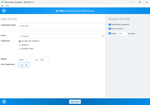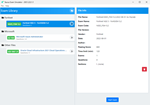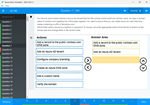Download Entry Certificate in Business Analysis.ECBA.VCEplus.2025-06-05.34q.tqb
| Vendor: | IIBA |
| Exam Code: | ECBA |
| Exam Name: | Entry Certificate in Business Analysis |
| Date: | Jun 05, 2025 |
| File Size: | 146 KB |
How to open TQB files?
Files with TQB (Taurus Question Bank) extension can be opened by Taurus Exam Studio.
Purchase
Coupon: TAURUSSIM_20OFF
Discount: 20%
Demo Questions
Question 1
During the requirement life cycle management, what should a business analyst (BA) do to extend the value of requirements beyond the current initiative?
- Assess
- Prioritize
- Trace
- Maintain
Correct answer: D
Explanation:
In Requirements Life Cycle Management, the task that extends the value of requirements beyond the current initiative is Maintain Requirements. This involves keeping requirements accurate, up to date, and available for reuse in future initiatives. Reusable requirements reduce the need for rework and improve organizational efficiency.Exact Extract from BABOK Guide v3 -- Section 5.3: Maintain Requirements:''The purpose of Maintain Requirements is to retain requirements accuracy and consistency throughout and beyond the change during the entire requirements life cycle and to support reuse where appropriate.'' In Requirements Life Cycle Management, the task that extends the value of requirements beyond the current initiative is Maintain Requirements. This involves keeping requirements accurate, up to date, and available for reuse in future initiatives. Reusable requirements reduce the need for rework and improve organizational efficiency.
Exact Extract from BABOK Guide v3 -- Section 5.3: Maintain Requirements:
''The purpose of Maintain Requirements is to retain requirements accuracy and consistency throughout and beyond the change during the entire requirements life cycle and to support reuse where appropriate.''
Question 2
Why consider both tangible and intangible costs and benefits when determining the value of a solution?
- To present the case to team leaders
- To ensure the finance team budgets for the software
- To ensure the business case template is complete
- To present a complete estimate to the business
Correct answer: D
Explanation:
Considering both tangible and intangible costs and benefits provides a complete estimate of the solution's value to the business. Tangible elements are directly measurable (e.g., cost savings, revenue), while intangible benefits (e.g., customer satisfaction, brand reputation) contribute to the strategic vision and long-term value.Exact Extract from BABOK Guide v3 -- Section 7.6: Analyze Potential Value and Recommend Solution:''Consideration should be given to both tangible and intangible value, including potential benefits and costs, to understand the overall impact of a proposed solution.'' Considering both tangible and intangible costs and benefits provides a complete estimate of the solution's value to the business. Tangible elements are directly measurable (e.g., cost savings, revenue), while intangible benefits (e.g., customer satisfaction, brand reputation) contribute to the strategic vision and long-term value.
Exact Extract from BABOK Guide v3 -- Section 7.6: Analyze Potential Value and Recommend Solution:
''Consideration should be given to both tangible and intangible value, including potential benefits and costs, to understand the overall impact of a proposed solution.''
Question 3
Which elicitation type involves the discovery of information under controlled tests?
- Experiment
- Workshop
- Collaborative
- Research
Correct answer: A
Explanation:
The experiment elicitation technique involves discovering information under controlled conditions or tests. This approach is valuable when theoretical or observed behavior needs to be validated through actual performance or test conditions, often used in prototyping and usability testing.Exact Extract from BABOK Guide v3 -- Technique 10.16: Experiment:''Experiments are used to identify information when it is not available from other sources or when it is desirable to confirm an assumption or hypothesis under controlled conditions.'' The experiment elicitation technique involves discovering information under controlled conditions or tests. This approach is valuable when theoretical or observed behavior needs to be validated through actual performance or test conditions, often used in prototyping and usability testing.
Exact Extract from BABOK Guide v3 -- Technique 10.16: Experiment:
''Experiments are used to identify information when it is not available from other sources or when it is desirable to confirm an assumption or hypothesis under controlled conditions.''
Question 4
The business analysis core concept model (BACCM) describes which of the following as 'the act of transformation in response to a need'?
- Context
- Need
- Solution
- Change
Correct answer: D
Explanation:
In the Business Analysis Core Concept Model (BACCM), Change is defined as ''the act of transformation in response to a need''. It is central to business analysis, as all efforts revolve around enabling or managing change that delivers value.Exact Extract from BABOK Guide v3 -- BACCM Core Concept: Change:''Change is the act of transformation in response to a need. The purpose of change is to improve the performance of an enterprise.'' In the Business Analysis Core Concept Model (BACCM), Change is defined as ''the act of transformation in response to a need''. It is central to business analysis, as all efforts revolve around enabling or managing change that delivers value.
Exact Extract from BABOK Guide v3 -- BACCM Core Concept: Change:
''Change is the act of transformation in response to a need. The purpose of change is to improve the performance of an enterprise.''
Question 5
Which of the following is a common change that can be made to a process in order to improve it?
- Analyze the potential impact of the change
- Generate and evaluate options
- Automate steps that are more routine and predictable
- Understand the relationship between gaps and improvement areas
Correct answer: C
Explanation:
Automating steps that are more routine and predictable is a common change made to improve a process. This approach helps in reducing human errors, speeding up the process, and freeing up human resources to focus on more complex tasks. Automation ensures consistency and reliability in the execution of routine tasks, leading to increased efficiency and productivity within the process. For example, implementing workflow management systems or straight-through processing can significantly enhance the efficiency of business operations.* Business Analysis.pdf, Section on 'Redesign the process' which discusses automating steps to improve process efficiency . Automating steps that are more routine and predictable is a common change made to improve a process. This approach helps in reducing human errors, speeding up the process, and freeing up human resources to focus on more complex tasks. Automation ensures consistency and reliability in the execution of routine tasks, leading to increased efficiency and productivity within the process. For example, implementing workflow management systems or straight-through processing can significantly enhance the efficiency of business operations.
* Business Analysis.pdf, Section on 'Redesign the process' which discusses automating steps to improve process efficiency .
Question 6
In planning an information management approach, what input element indicates the current status of stored information?
- Repository
- Storage decision
- Organizational standard
- Tool
Correct answer: A
Explanation:
In planning an information management approach, a repository is the input element that indicates the current status of stored information. A repository provides a centralized location where information is stored, managed,and retrieved. It gives a clear picture of the current data landscape, including what data is available, how it is organized, and how it can be accessed. This is crucial for effective information management as it helps in assessing the completeness, accuracy, and relevance of the information stored.* Business Analysis.pdf, Section on 'Information Management,' which discusses the role of repositories in managing stored information. In planning an information management approach, a repository is the input element that indicates the current status of stored information. A repository provides a centralized location where information is stored, managed,and retrieved. It gives a clear picture of the current data landscape, including what data is available, how it is organized, and how it can be accessed. This is crucial for effective information management as it helps in assessing the completeness, accuracy, and relevance of the information stored.
* Business Analysis.pdf, Section on 'Information Management,' which discusses the role of repositories in managing stored information.
Question 7
Why must business analysis information packages be prepared?
- To determine the information management approach
- To plan tasks for the week
- To determine the stakeholder engagement approach
- To facilitate reviews and approvals
Correct answer: D
Explanation:
Business analysis information packages are prepared to facilitate reviews and approvals. These packages compile essential information in a structured format, making it easier for stakeholders to review the content and provide feedback or approval. This ensures that all relevant information is considered and that decisions are made based on a comprehensive understanding of the issues, requirements, and proposed solutions. Effective preparation of these packages helps streamline the review process and supports better decision-making.* Business Analysis.pdf, Section on 'Requirements Documentation,' which highlights the importance of documentation for reviews and approvals. Business analysis information packages are prepared to facilitate reviews and approvals. These packages compile essential information in a structured format, making it easier for stakeholders to review the content and provide feedback or approval. This ensures that all relevant information is considered and that decisions are made based on a comprehensive understanding of the issues, requirements, and proposed solutions. Effective preparation of these packages helps streamline the review process and supports better decision-making.
* Business Analysis.pdf, Section on 'Requirements Documentation,' which highlights the importance of documentation for reviews and approvals.
Question 8
What is an example of a tacit business rule?
- Accepted practice
- Corporate policy
- Job aid
- Corporate contract
Correct answer: A
Explanation:
An accepted practice is an example of a tacit business rule. Tacit business rules are those that are understood and followed by members of the organization but are not formally documented. They are often derived from the culture, norms, and shared understandings within the organization. These rules govern everyday behavior and decision-making processes implicitly, guiding how tasks are performed and how interactions occur without explicit instruction.* Business Analysis.pdf, Section on 'Business Rules,' which explains tacit business rules and gives examples of accepted practices within organizations . An accepted practice is an example of a tacit business rule. Tacit business rules are those that are understood and followed by members of the organization but are not formally documented. They are often derived from the culture, norms, and shared understandings within the organization. These rules govern everyday behavior and decision-making processes implicitly, guiding how tasks are performed and how interactions occur without explicit instruction.
* Business Analysis.pdf, Section on 'Business Rules,' which explains tacit business rules and gives examples of accepted practices within organizations .
Question 9
How does the use of a traceability repository help in achieving project goals?
- Tracks changes to project artifacts
- Documents requirements lineage
- Identifies and mitigates project risks
- Stores stakeholder communications
Correct answer: B
Explanation:
A traceability repository is a critical tool in business analysis that helps in documenting the lineage of requirements. This means it records the origin, development, and interrelationships of each requirement throughout the project lifecycle. By maintaining this detailed record, the repository ensures that every requirement is aligned with business objectives and stakeholder needs, facilitating effective project management and goal attainment.Key Benefits of a Traceability Repository:Alignment with Business Objectives: Ensures that each requirement is directly linked to business goals, confirming that the project remains focused on delivering value.Impact Analysis: Facilitates the assessment of the implications of changes in requirements, aiding in decision-making and risk management.Scope Management: Helps in identifying and managing the scope of the project by tracking which requirements are included or excluded.Verification and Validation: Supports the processes of verifying that the solution meets the requirements and validating that the requirements meet stakeholder needs.Extract from BABOK Guide v3:''Requirements traceability identifies and documents the lineage of each requirement, including its backward traceability, its forward traceability, and its relationship to other requirements. Traceability is used to help ensure that the solution conforms to requirements and to assist in scope, change, risk, time, cost, and communication management.'' --- BABOK Guide v3, Section 5.1.2 DescriptionBABOK Guide v3, Section 5.1: Trace RequirementsBABOK Guide v3, Section 5.1.2: DescriptionBy documenting the requirements lineage, a traceability repository plays a pivotal role in ensuring that the project remains aligned with its goals, thereby enhancing the likelihood of its success. A traceability repository is a critical tool in business analysis that helps in documenting the lineage of requirements. This means it records the origin, development, and interrelationships of each requirement throughout the project lifecycle. By maintaining this detailed record, the repository ensures that every requirement is aligned with business objectives and stakeholder needs, facilitating effective project management and goal attainment.
Key Benefits of a Traceability Repository:
Alignment with Business Objectives: Ensures that each requirement is directly linked to business goals, confirming that the project remains focused on delivering value.
Impact Analysis: Facilitates the assessment of the implications of changes in requirements, aiding in decision-making and risk management.
Scope Management: Helps in identifying and managing the scope of the project by tracking which requirements are included or excluded.
Verification and Validation: Supports the processes of verifying that the solution meets the requirements and validating that the requirements meet stakeholder needs.
Extract from BABOK Guide v3:
''Requirements traceability identifies and documents the lineage of each requirement, including its backward traceability, its forward traceability, and its relationship to other requirements. Traceability is used to help ensure that the solution conforms to requirements and to assist in scope, change, risk, time, cost, and communication management.'' --- BABOK Guide v3, Section 5.1.2 Description
BABOK Guide v3, Section 5.1: Trace Requirements
BABOK Guide v3, Section 5.1.2: Description
By documenting the requirements lineage, a traceability repository plays a pivotal role in ensuring that the project remains aligned with its goals, thereby enhancing the likelihood of its success.
Question 10
What are the elements of user stories?
- State tables, flow diagrams, process models, matrices
- Grouping, ranking, negotiation, decision trees
- Main topic, keywords, metrics, indicators
- Conversation, acceptance criteria, title, statement of value
Correct answer: D
Explanation:
User stories are a fundamental component in Agile methodologies, serving as concise, user-centric descriptions of desired functionalities. They are designed to facilitate communication among stakeholders and ensure that the development team understands the requirements from the user's perspective.Key Elements of User Stories:Title: A brief, descriptive name that captures the essence of the user story. It helps in identifying and referencing the story easily.Statement of Value: This follows the format: 'As a [user role], I want [goal] so that [benefit].' It clearly articulates who the user is, what they need, and why they need it, ensuring that the focus remains on delivering value.Conversation: Represents the collaborative discussions between stakeholders and the development team. These conversations delve deeper into the details of the user story, clarifying requirements and expectations.Acceptance Criteria: Specific conditions that must be met for the user story to be considered complete. They provide a clear definition of done and guide the development and testing processes.Reference from BABOK Guide v3:According to the BABOK Guide v3, user stories are a technique used to capture a description of a software feature from an end-user perspective. They are typically composed of a title, a statement of value, conversations to elaborate on the details, and acceptance criteria to define the boundaries and conditions for success. User stories are a fundamental component in Agile methodologies, serving as concise, user-centric descriptions of desired functionalities. They are designed to facilitate communication among stakeholders and ensure that the development team understands the requirements from the user's perspective.
Key Elements of User Stories:
Title: A brief, descriptive name that captures the essence of the user story. It helps in identifying and referencing the story easily.
Statement of Value: This follows the format: 'As a [user role], I want [goal] so that [benefit].' It clearly articulates who the user is, what they need, and why they need it, ensuring that the focus remains on delivering value.
Conversation: Represents the collaborative discussions between stakeholders and the development team. These conversations delve deeper into the details of the user story, clarifying requirements and expectations.
Acceptance Criteria: Specific conditions that must be met for the user story to be considered complete. They provide a clear definition of done and guide the development and testing processes.
Reference from BABOK Guide v3:
According to the BABOK Guide v3, user stories are a technique used to capture a description of a software feature from an end-user perspective. They are typically composed of a title, a statement of value, conversations to elaborate on the details, and acceptance criteria to define the boundaries and conditions for success.
HOW TO OPEN VCE FILES
Use VCE Exam Simulator to open VCE files
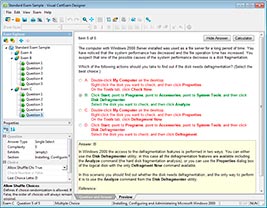
HOW TO OPEN VCEX FILES
Use ProfExam Simulator to open VCEX files
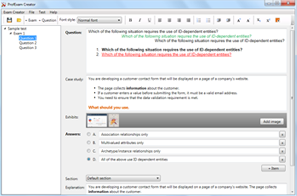

ProfExam at a 20% markdown
You have the opportunity to purchase ProfExam at a 20% reduced price
Get Now!